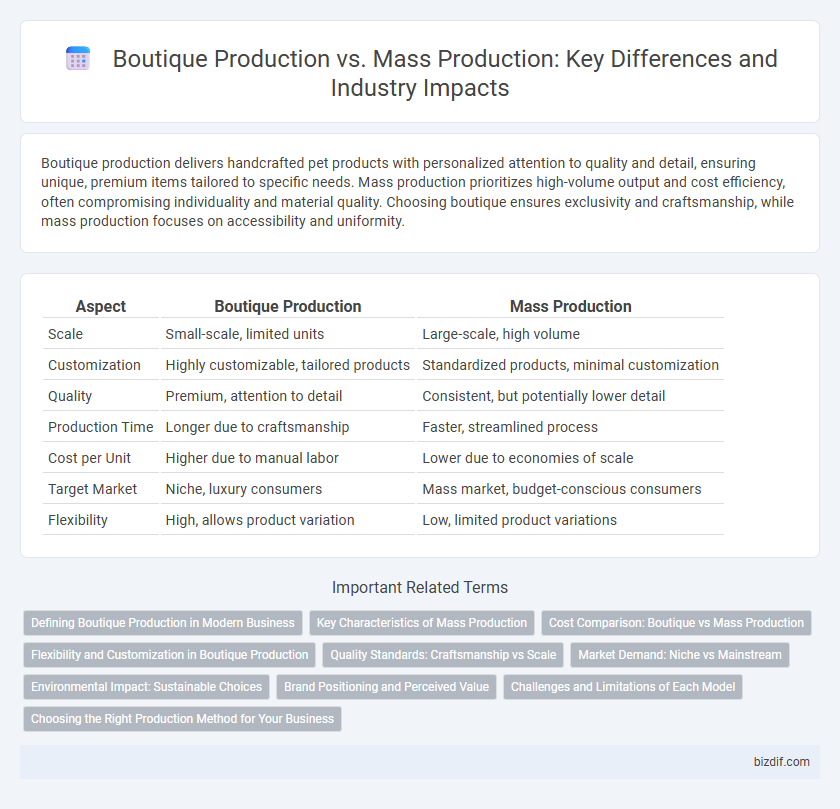Boutique production delivers handcrafted pet products with personalized attention to quality and detail, ensuring unique, premium items tailored to specific needs. Mass production prioritizes high-volume output and cost efficiency, often compromising individuality and material quality. Choosing boutique ensures exclusivity and craftsmanship, while mass production focuses on accessibility and uniformity.
Table of Comparison
| Aspect | Boutique Production | Mass Production |
|---|---|---|
| Scale | Small-scale, limited units | Large-scale, high volume |
| Customization | Highly customizable, tailored products | Standardized products, minimal customization |
| Quality | Premium, attention to detail | Consistent, but potentially lower detail |
| Production Time | Longer due to craftsmanship | Faster, streamlined process |
| Cost per Unit | Higher due to manual labor | Lower due to economies of scale |
| Target Market | Niche, luxury consumers | Mass market, budget-conscious consumers |
| Flexibility | High, allows product variation | Low, limited product variations |
Defining Boutique Production in Modern Business
Boutique production in modern business emphasizes small-scale, highly specialized manufacturing that delivers unique, handcrafted products tailored to niche markets. This approach contrasts with mass production by prioritizing quality, customization, and exclusivity over volume and uniformity. Companies adopting boutique production often leverage skilled artisans and advanced technologies to create distinct offerings that command premium pricing and foster brand loyalty.
Key Characteristics of Mass Production
Mass production is characterized by high-volume output using standardized processes and assembly lines, enabling efficient manufacturing of identical products at low cost. It relies on automation and specialized machinery to ensure consistency, reduce production time, and minimize labor costs. The approach maximizes economies of scale but often sacrifices customization and flexibility compared to boutique production.
Cost Comparison: Boutique vs Mass Production
Boutique production typically incurs higher costs per unit due to smaller batch sizes, artisanal craftsmanship, and premium materials, leading to elevated labor and overhead expenses. Mass production benefits from economies of scale, reducing costs significantly through automated processes, bulk purchasing, and streamlined operations. While boutique production emphasizes quality and uniqueness, mass production offers cost efficiency and affordability for large-scale distribution.
Flexibility and Customization in Boutique Production
Boutique production excels in flexibility by allowing small-scale, tailored manufacturing processes that adapt quickly to client specifications, unlike mass production which relies on standardized, high-volume output. Customization is a hallmark of boutique production, enabling unique product variations and personalized designs that meet individual customer demands. This approach fosters greater innovation and quality control, resulting in exclusive, high-value products that mass production methods typically cannot replicate.
Quality Standards: Craftsmanship vs Scale
Boutique production emphasizes meticulous craftsmanship, ensuring each product meets the highest quality standards through detailed, hands-on processes. In contrast, mass production prioritizes scale and efficiency, often sacrificing individual attention and the fine details that define premium quality. This focus on artisanal techniques in boutique settings results in unique, durable products that stand apart from uniform mass-produced goods.
Market Demand: Niche vs Mainstream
Boutique production caters to niche markets by offering highly customized, limited-edition products that meet specific customer preferences, contrasting with mass production's focus on mainstream demand and standardized goods. Market demand for boutique products often stems from consumers seeking uniqueness and exclusivity, resulting in lower volume but higher value sales. In contrast, mass production targets broad consumer bases, emphasizing economies of scale and cost efficiency to satisfy widespread market needs.
Environmental Impact: Sustainable Choices
Boutique production significantly reduces environmental impact by utilizing local materials and minimizing waste through handcrafted processes, contrasting with mass production's extensive use of non-renewable resources and high emissions. Sustainable choices in boutique manufacturing emphasize eco-friendly sourcing, energy efficiency, and limited batch sizes, which collectively lower carbon footprints and promote circular economy principles. This approach supports biodiversity and reduces pollution, making it a responsible alternative to the resource-intensive and often polluting mass production systems.
Brand Positioning and Perceived Value
Boutique production emphasizes craftsmanship and exclusivity, enhancing brand positioning by appealing to niche markets seeking unique, high-quality products. This approach elevates perceived value through limited quantities and personalized experiences, differentiating the brand from mass-produced alternatives. Mass production, while ensuring affordability and widespread availability, often dilutes brand prestige and reduces perceived uniqueness.
Challenges and Limitations of Each Model
Boutique production faces challenges such as higher per-unit costs due to limited economies of scale and reliance on skilled artisans, which can slow output and limit scalability. Mass production struggles with maintaining product uniqueness and customization, often sacrificing quality and customer experience for efficiency and large volume output. Both models encounter supply chain complexities, with boutique production demanding specialized materials and mass production requiring high-volume, consistent supply.
Choosing the Right Production Method for Your Business
Boutique production offers personalized, high-quality products tailored to niche markets, while mass production prioritizes cost efficiency and large-scale output. Choosing the right production method depends on your business goals, target audience, and resource availability; boutique production suits luxury and custom goods, whereas mass production fits standard, high-demand items. Evaluating product complexity, market demand, and budget constraints ensures alignment with your brand's value proposition and long-term growth strategy.
Boutique Production vs Mass Production Infographic

 bizdif.com
bizdif.com